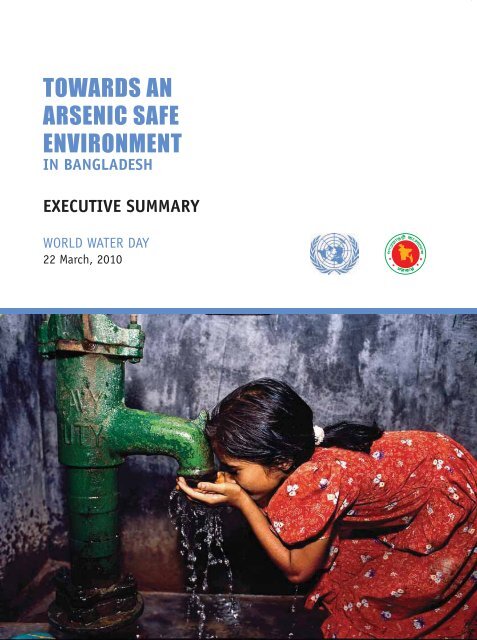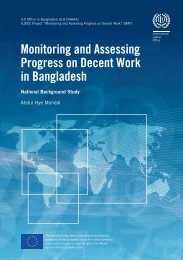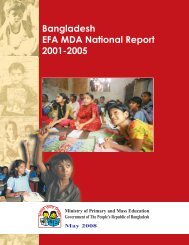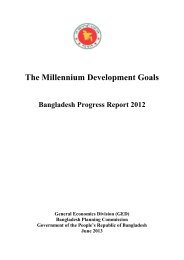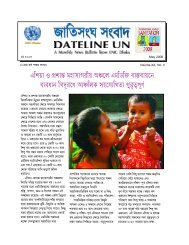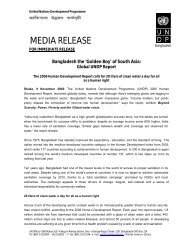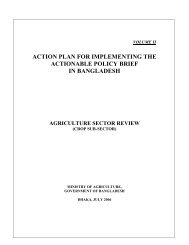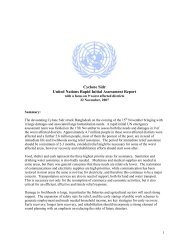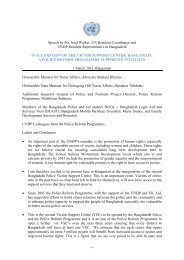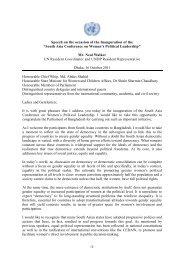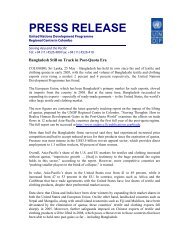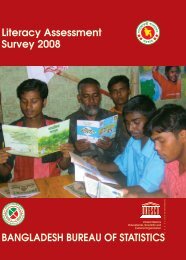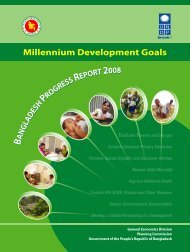Towards an Arsenic Safe Environment in Bangladesh - Unicef
Towards an Arsenic Safe Environment in Bangladesh - Unicef
Towards an Arsenic Safe Environment in Bangladesh - Unicef
- No tags were found...
Create successful ePaper yourself
Turn your PDF publications into a flip-book with our unique Google optimized e-Paper software.
TOWARDS ANARSENIC SAFEENVIRONMENTIN BANGLADESHEXECUTIVE SUMMARYWORLD WATER DAY22 March, 2010
Executive SummaryMarch 2010
INTRODUCTIONIt was thought that B<strong>an</strong>gladesh had succeeded <strong>in</strong> offer<strong>in</strong>g safe dr<strong>in</strong>k<strong>in</strong>gwater to the vast majority of its population through tube wells with h<strong>an</strong>dpumps by the early 1990s. However, dur<strong>in</strong>g the same decade this success waschallenged by the discovery of widespread arsenic contam<strong>in</strong>ation exceed<strong>in</strong>gthe B<strong>an</strong>gladesh dr<strong>in</strong>k<strong>in</strong>g water st<strong>an</strong>dard of 50 microgram per liter. Severalscreen<strong>in</strong>g campaigns have determ<strong>in</strong>ed the extent <strong>an</strong>d severity of arseniccontam<strong>in</strong>ation. Tens of millions of people were at risk, reduc<strong>in</strong>g the safewater coverage of B<strong>an</strong>gladesh from nearly universal to about 80%. TheGovernment of B<strong>an</strong>gladesh together with stakeholders have undertaken ar<strong>an</strong>ge of arsenic mitigation strategies guided by the National Policy for<strong>Arsenic</strong> Mitigation issued <strong>in</strong> 2004, <strong>an</strong>d the Implementation Pl<strong>an</strong> for <strong>Arsenic</strong>Mitigation. Both the public <strong>an</strong>d the private sectors have made signific<strong>an</strong>tprogress towards mitigation.The Government ofB<strong>an</strong>gladesh electedon J<strong>an</strong>uary 6, 2009committed <strong>in</strong> itselection m<strong>an</strong>ifestothat the arsenicproblem will betackled <strong>an</strong>dmeasures will betaken to ensurethe supply of safedr<strong>in</strong>k<strong>in</strong>g water forall by 2011.However as of 2009 this problem is far from solved, jeopardiz<strong>in</strong>g theprogress towards achiev<strong>in</strong>g the Millennium Development Goals. Despitemassive efforts to provide safe water supplies <strong>in</strong> arsenic-affected areas, awater quality survey <strong>in</strong> 2009 by the B<strong>an</strong>gladesh Bureau of Statistics <strong>an</strong>dUNICEF has found that 12.6% of dr<strong>in</strong>k<strong>in</strong>g water samples collected from13,423 households around the country do not meet the B<strong>an</strong>gladesh dr<strong>in</strong>k<strong>in</strong>gwater st<strong>an</strong>dard for arsenic (Figure 1). This is equivalent to approximately 20million people still be<strong>in</strong>g exposed to excessive qu<strong>an</strong>tities of arsenic. Recentknowledge of the health threats posed by arsenic, as well as evidence ofarsenic penetration <strong>in</strong>to the food cha<strong>in</strong> make urgent action absolutelyessential. In recognition of the cont<strong>in</strong>u<strong>in</strong>g challenge posed by arsenic, thepresent Government of B<strong>an</strong>gladesh committed <strong>in</strong> its election m<strong>an</strong>ifesto that“the arsenic problem will be tackled <strong>an</strong>d measures will be taken to supplydr<strong>in</strong>k<strong>in</strong>g water for all by 2011.” This document stresses the urgency of thesituation <strong>an</strong>d recommends key actions to be taken to achieve this goal.
Figure 1. NAMIC datadepict<strong>in</strong>g the extent ofarsenic contam<strong>in</strong>ation oftube wells based on surveys<strong>in</strong> 2002 <strong>an</strong>d 2003 (topp<strong>an</strong>el), <strong>an</strong>d the B<strong>an</strong>gladeshBureau of Statistics (BBS)<strong>an</strong>d UNICEF MultipleIndicator Cluster Surveydata depict<strong>in</strong>g the extent ofarsenic contam<strong>in</strong>ation ofhousehold dr<strong>in</strong>k<strong>in</strong>g water <strong>in</strong>2009 (bottom p<strong>an</strong>el).02/03
WHAT HAS BEENDONEAfter the detection of arsenic <strong>in</strong> the groundwater <strong>in</strong> the 1990s, a series of<strong>in</strong>itiatives were undertaken by the government, non-governmental org<strong>an</strong>izations(NGOs) <strong>an</strong>d development partners. This resulted <strong>in</strong> a reasonable assessment of theextent of arsenic problem from tube wells (Figure 1).Almost 5 million of h<strong>an</strong>d pumps <strong>an</strong>d tube wells across the country weredemarcated red or green to <strong>in</strong>dicate arsenic level. The red pa<strong>in</strong>ted wells are <strong>in</strong>exceed<strong>an</strong>ce of the B<strong>an</strong>gladesh dr<strong>in</strong>k<strong>in</strong>g water st<strong>an</strong>dard for arsenic, whereas thegreen pa<strong>in</strong>ted wells are <strong>in</strong> compli<strong>an</strong>ce. The red/green pa<strong>in</strong>t<strong>in</strong>g of the wells hasbeen a powerful way of <strong>in</strong>form<strong>in</strong>g users of the status of the arseniccontam<strong>in</strong>ation. However, this has not always been sufficient to prompt the usersto switch from the red pa<strong>in</strong>ted wells to the green pa<strong>in</strong>ted wells, <strong>an</strong>d the pa<strong>in</strong>tedcolor did not last long.More th<strong>an</strong> 100,000 safe water po<strong>in</strong>ts have been <strong>in</strong>stalled <strong>in</strong> arsenic affected areass<strong>in</strong>ce the discovery of the arsenic problem, with the great majority be<strong>in</strong>g deeptube wells. However, the target<strong>in</strong>g of these water sources to the most affectedareas has been poor <strong>an</strong>d <strong>an</strong> <strong>Arsenic</strong> Policy Support Unit study found that m<strong>an</strong>y ofthose water po<strong>in</strong>ts were not operational with the exception of deep tube wells.Six arsenic removal technologies have been approved by the B<strong>an</strong>gladesh Councilof Scientific <strong>an</strong>d Industrial Research. There are concerns regard<strong>in</strong>g theperform<strong>an</strong>ce, affordability <strong>an</strong>d susta<strong>in</strong>ability of these technologies.The no-longer exist<strong>in</strong>g National <strong>Arsenic</strong> Mitigation Information Centre (NAMIC)held a database of arsenic tube well screen<strong>in</strong>g results (Figure 1). This valuabledataset has now been <strong>in</strong>corporated <strong>in</strong>to <strong>an</strong>other government database to bepreserved, updated <strong>an</strong>d ultimately exp<strong>an</strong>ded to m<strong>an</strong>age groundwater resources<strong>an</strong>d to ensure dr<strong>in</strong>k<strong>in</strong>g water quality st<strong>an</strong>dards to be met <strong>in</strong> B<strong>an</strong>gladesh.Accord<strong>in</strong>g to the archived NAMIC dataset, of the 4.94 million wells screened, 1.44million were found to conta<strong>in</strong> arsenic above 50 microgram per liter <strong>in</strong> 270 upazilasfrom 54 districts. In these upazilas 38,430 suspected arsenicosis patients wereidentified out of the total 66,034,962 residents, although there are somequestions about the validity of the arsenicosis patient screen<strong>in</strong>g data.
04/05
THE POLICY AND INSTITUTIONALFRAMEWORKThe Government of B<strong>an</strong>gladesh has formulated policies for the three differentsectors affected by arsenic contam<strong>in</strong>ation <strong>in</strong> the ground water; namely theNational Agriculture Policy, National Water Policy <strong>an</strong>d National Health Policy;however there are no provisions for arsenic mitigation <strong>in</strong> these policies. Although<strong>an</strong> <strong>Arsenic</strong> Policy Support Unit <strong>an</strong>d a National Committee was established, underthe implementation pl<strong>an</strong> for <strong>Arsenic</strong> Mitigation of 2004, the <strong>Arsenic</strong> PolicySupport Unit no longer exists <strong>an</strong>d the National Committee is <strong>in</strong>active. Both thepolicy <strong>an</strong>d implementation pl<strong>an</strong> need to be revitalized by the Government tobr<strong>in</strong>g a new dynamism to arsenic mitigation <strong>in</strong> B<strong>an</strong>gladesh. A signific<strong>an</strong>t<strong>in</strong>stitutional review commissioned by the Local Government Division (LGD) of theM<strong>in</strong>istry of Local Government, Rural Development <strong>an</strong>d Co-operatives (MLGRD&C)<strong>an</strong>d the Policy Support Unit (PSU) called for a review of the Implementation Pl<strong>an</strong>for <strong>Arsenic</strong> Mitigation of 2004. This is a first crucial step towards revitaliz<strong>in</strong>garsenic mitigation.The LGD of the MLGRD&C is the nodal Government unit for m<strong>an</strong>ag<strong>in</strong>g the arsenicissue. Under the LGD; the Pourashavas, the City Corporations, the Water <strong>an</strong>dS<strong>an</strong>itation Authorities <strong>in</strong> Dhaka <strong>an</strong>d Chittagong, Local Government Eng<strong>in</strong>eer<strong>in</strong>gDepartment (LGED) <strong>an</strong>d the Department of Public Health Eng<strong>in</strong>eer<strong>in</strong>g (DPHE) havecontributed to arsenic mitigation. DPHE is the lead technical org<strong>an</strong>izationresponsible for support<strong>in</strong>g the LGD <strong>an</strong>d the local government <strong>in</strong>stitutions (LGIs)<strong>in</strong> pl<strong>an</strong>n<strong>in</strong>g <strong>an</strong>d delivery of solutions <strong>an</strong>d the m<strong>an</strong>agement of the arsenic problem.The LGIs have been delegated the responsibility to ensure safe water for all. Toexecute this responsibility, the LGIs c<strong>an</strong> deploy their social <strong>an</strong>d legal authority toleverage ‘test<strong>in</strong>g <strong>an</strong>d mark<strong>in</strong>g’ of all sources for arsenic contam<strong>in</strong>ation by all waterservice providers (i.e. public & private, households & communities) with<strong>in</strong> theirjurisdiction.One of the features of the <strong>in</strong>stitutional l<strong>an</strong>dscape is the very large number ofagencies (governmental <strong>an</strong>d non-governmental) engaged <strong>in</strong> arsenic-related<strong>in</strong>terventions. Coord<strong>in</strong>ation is challeng<strong>in</strong>g not least because of the multi-sectoralnature of the problem.
<strong>Arsenic</strong> awareness campaign <strong>in</strong> schools06/07
EMERGINGTHREATSThough considerable attention was <strong>in</strong>itially focused on the arsenic issue, thisproblem has received little attention by both Government <strong>an</strong>d developmentpartners over the last five years. However, recent scientific f<strong>in</strong>d<strong>in</strong>gs call for urgentaction:• The recognition that <strong>in</strong> addition to c<strong>an</strong>cers, arsenic c<strong>an</strong> lead to signific<strong>an</strong>tly<strong>in</strong>creased mortality from heart attacks <strong>an</strong>d other cardio-pulmonary diseases.• The recognition that <strong>in</strong> addition to c<strong>an</strong>cers, arsenic c<strong>an</strong> impair the <strong>in</strong>tellectualfunction of children.• The possibility that arsenic from groundwater used for irrigation c<strong>an</strong> reducecrop yield.• The possibility of arsenic from ground water enter<strong>in</strong>g the food cha<strong>in</strong> throughits accumulation <strong>in</strong>to rice, the rice straw that is used as <strong>an</strong>imal fodder, as wellas <strong>in</strong> other crops.Though more research needs to be undertaken to ascerta<strong>in</strong> the full impact of thesef<strong>in</strong>d<strong>in</strong>gs <strong>in</strong> the B<strong>an</strong>gladesh context, the potential consequence justifies that proactiveaction should be taken to reduce exposure to arsenic from dr<strong>in</strong>k<strong>in</strong>g water<strong>an</strong>d to develop coord<strong>in</strong>ated implementation pl<strong>an</strong>s for arsenic mitigation <strong>in</strong> health,agriculture, water supply <strong>an</strong>d water resources sectors.
HEALTHWhile sk<strong>in</strong> lesions are the best-known symptom of arsenicosis they are not lifethreaten<strong>in</strong>g. Furthermore, m<strong>an</strong>y people exposed to arsenic will never show sk<strong>in</strong>lesions but may still go on to develop lung, cardiovascular disease <strong>an</strong>d c<strong>an</strong>cer asa direct consequence of this exposure. Children are particularly vulnerable toarsenic poison<strong>in</strong>g, <strong>an</strong>d are much more likely to face adverse health impacts th<strong>an</strong>adults. There is <strong>an</strong> <strong>in</strong>creas<strong>in</strong>g body of evidence that prenatal arsenic exposure isassociated with signific<strong>an</strong>t morbidity <strong>an</strong>d mortality later <strong>in</strong> life due to lung,cardiovascular disease <strong>an</strong>d c<strong>an</strong>cer. The commonly reported symptoms of chronicarsenic exposure are mel<strong>an</strong>osis, keratosis, ulcer, g<strong>an</strong>grene, peripheral vasculardisorder, chronic lung disease, kidney failure, liver failure, cardiac diseases, sk<strong>in</strong>c<strong>an</strong>cer, <strong>an</strong>d a number of <strong>in</strong>ternal c<strong>an</strong>cers. <strong>Arsenic</strong> leads to very high excessdeaths; there is high latency for c<strong>an</strong>cers but less for heart attacks; <strong>an</strong>d for bothc<strong>an</strong>cers <strong>an</strong>d heart attacks, men are more vulnerable th<strong>an</strong> women.Figure 2: Hum<strong>an</strong> exposure pathways to <strong>Arsenic</strong> 1Estimates of the economic impact of poor health aris<strong>in</strong>g from arsenic <strong>in</strong>groundwater <strong>in</strong> B<strong>an</strong>gladesh suggest that the cost of <strong>in</strong>action is extremely high.The Gross Domestic Product (GDP) output lost due to illness <strong>an</strong>d people becom<strong>in</strong>gunable to work is estimated to be US$23 billion while the cost of treat<strong>in</strong>g arsenicrelateddiseases is estimated to be much lower at US$0.6 billion for a const<strong>an</strong>tdiscount rate of 10% over a 50-year period. This suggests that while the costs tothe health care system are large, the costs to the economy due to loss <strong>in</strong>productivity are at least <strong>an</strong> order of magnitude greater.1 <strong>Arsenic</strong> may also enter the hum<strong>an</strong> food cha<strong>in</strong> via arsenic-contam<strong>in</strong>ated <strong>an</strong>imal fodder <strong>an</strong>d frommilk provided by As-affected cattle08/09
The primary treatment for arsenic poison<strong>in</strong>g is to reduce ongo<strong>in</strong>g exposure as much<strong>an</strong>d as quickly as possible. Hum<strong>an</strong> exposure to arsenic occurs through a number ofdifferent routes (see Figure 2). Besides this, micronutrients such as vitam<strong>in</strong>s A, C,E, z<strong>in</strong>c, selenium <strong>an</strong>d folic acid have been shown to be effective <strong>in</strong> the alleviationof arsenicosis symptoms, specifically sk<strong>in</strong> lesions <strong>an</strong>d <strong>in</strong> accelerat<strong>in</strong>g the naturalexcretion of arsenic from the body. These are all essential vitam<strong>in</strong>s <strong>an</strong>d m<strong>in</strong>erals,yet care is needed to ensure that these are not prescribed <strong>in</strong> excessive, potentiallytoxic dosages. Most of these compounds require between 6 <strong>an</strong>d 12 monthstreatment to be effective <strong>an</strong>d even then recurrence rates are high.More research is needed to f<strong>in</strong>d alternate therapies which are effective with<strong>in</strong> ashorter period (2-4 weeks) with m<strong>in</strong>imum adverse effects. Potential treatmentsus<strong>in</strong>g spirul<strong>in</strong>a, garlic <strong>an</strong>d maize have been suggested based on <strong>an</strong> <strong>an</strong>imal model.
FOODSAFETYThe impact of arsenic on food safety is <strong>in</strong>creas<strong>in</strong>gly be<strong>in</strong>g recognized. Recentdata on total <strong>an</strong>d <strong>in</strong>org<strong>an</strong>ic arsenic <strong>in</strong> rice <strong>an</strong>d vegetables from some districts ofsouthwestern B<strong>an</strong>gladesh <strong>in</strong>dicate that rice c<strong>an</strong> contribute signific<strong>an</strong>tly to thedaily <strong>in</strong>take of arsenic. The average daily <strong>in</strong>take of arsenic from rice for aB<strong>an</strong>gladeshi adult is approximately 100 microgram, equivalent to consumption of2 liters of water if the water conta<strong>in</strong>s arsenic at the B<strong>an</strong>gladesh dr<strong>in</strong>k<strong>in</strong>g waterlimit of 50 microgram per liter. The WHO Provisional Maximum Tolerable DailyIntake (PMTDI) for <strong>an</strong> adult is 140 microgram arsenic per 65 kg body mass. Inparts of the country arsenic levels <strong>in</strong> rice are higher th<strong>an</strong> average becauseirrigation water conta<strong>in</strong> high arsenic. In Faridpur, for example, boro riceconsumption leads to <strong>an</strong> average <strong>in</strong>take of 150% of the PMTDI. However, furtherresearch is needed to ascerta<strong>in</strong> the full impact of these f<strong>in</strong>d<strong>in</strong>gs, especiallybecause there is no evidence yet to suggest that arsenic <strong>in</strong> rice at thisconcentration is toxic to hum<strong>an</strong>s.In addition to arsenic concentration <strong>in</strong> edible crops, arsenic may also enter thefood cha<strong>in</strong> through fodder crops (Figure 2). Rice straw is the ma<strong>in</strong> cattle/buffalofeed <strong>in</strong> B<strong>an</strong>gladesh <strong>an</strong>d arsenic-contam<strong>in</strong>ated straw could impact <strong>an</strong>imal health<strong>an</strong>d the quality of <strong>an</strong>imal products. It has been found that cattle m<strong>an</strong>ure hasapproximately the same arsenic concentration as straw feed. M<strong>an</strong>ure is also usedas a kitchen fuel, which provides <strong>an</strong> additional route for hum<strong>an</strong> exposure toarsenic.10/11
FOODSECURITYThe cont<strong>in</strong>uous build up of arsenic <strong>in</strong> the soil from arsenic-contam<strong>in</strong>atedirrigation water may reduce crop yields. Evidence from field trials <strong>in</strong>B<strong>an</strong>gladesh tends to confirm that arsenic accumulation <strong>in</strong> soils isnegatively affect<strong>in</strong>g productivity.In the short-term it seems unlikely that B<strong>an</strong>gladesh will be able to lessenits reli<strong>an</strong>ce on irrigation from tube-wells for crop cultivation although the<strong>in</strong>creased use of surface water appears to be a sensible option to beconsidered where it is technically feasible.To reduce the negative impact of arsenic on food safety <strong>an</strong>d security, afocus on mitigat<strong>in</strong>g arsenic <strong>in</strong> irrigation water may be the most realisticstrategy <strong>in</strong> the short term. Other short-term options <strong>in</strong>clude substitut<strong>in</strong>gcrops which are more arsenic toler<strong>an</strong>t <strong>an</strong>d mak<strong>in</strong>g use of cultivationtechniques such as raised-bed cropp<strong>in</strong>g. In the medium-long term breed<strong>in</strong>g<strong>an</strong>d the propagation of arsenic-toler<strong>an</strong>t stra<strong>in</strong>s may be import<strong>an</strong>t. Breed<strong>in</strong>gprograms could also focus on the development of stra<strong>in</strong>s which require lessirrigation. This potentially c<strong>an</strong> be a second “green revolution” to reduce theneed for application of arsenic-contam<strong>in</strong>ated water. This would haveadditional benefits <strong>in</strong> reduc<strong>in</strong>g the costs of cultivation <strong>an</strong>d cutt<strong>in</strong>ggreenhouse gas emissions.
WATERSUPPLYThere has been progress <strong>in</strong> safe water provision. A recent situation <strong>an</strong>alysis foundthat of the 22 million people resid<strong>in</strong>g <strong>in</strong> areas where more th<strong>an</strong> 40% of wells haveunsafe level of arsenic, 12 million have been provided safe water options.However, <strong>in</strong> the most affected areas where more th<strong>an</strong> 80% of wells display unsafelevel of arsenic, only 4 out of the total 9 million residents have been providedalternative safe water options by the government (Table 1). Therefore, <strong>an</strong> urgenttask is to reach the millions still without arsenic safe water <strong>in</strong> these highlyaffected areas. Approximately 20 million people are still be<strong>in</strong>g exposed toexcessive qu<strong>an</strong>tities of arsenic <strong>in</strong> 2009.Table 1. Total population vs. population with public safe water<strong>in</strong> the most affected areas*where NAMIC data found >80% wells conta<strong>in</strong><strong>in</strong>g > 50 ug/L arsenic <strong>in</strong> 434 unions <strong>in</strong> 5 districts(Source: Situation Analysis of <strong>Arsenic</strong> Mitigation 2009. JICA/DPHE)Of the various water supply options that have been endorsed by the NationalPolicy for <strong>Arsenic</strong> Mitigation of 2004 for use <strong>in</strong> arsenic-affected areas, deep tubewells emerged as the preferred option even though the policy gives preference tothe use of surface water over the use of groundwater. Deep tube wells are apopular option because they resemble the shallow tube wells which people havegrown to consider safe. Tube wells also provide water that is largely safe fromfecal contam<strong>in</strong>ation, thus ensur<strong>in</strong>g that health ga<strong>in</strong>s on diarrhea <strong>an</strong>d other fecaloraldiseases are not lost. However, there were valid concerns about the risk ofcontam<strong>in</strong>at<strong>in</strong>g the deep aquifer with arsenic drawn down from shallow depths.S<strong>in</strong>ce then, studies have shown that when the deep aquifer is used only fordomestic water supply but not for irrigation, the risk of arsenic contam<strong>in</strong>ation isnegligible. However, if crop irrigation, which accounts for about 90% of allgroundwater use, is also made from the deep aquifer, there c<strong>an</strong> be a real risk ofarsenic contam<strong>in</strong>ation. These new f<strong>in</strong>d<strong>in</strong>gs highlight the import<strong>an</strong>ce ofm<strong>an</strong>agement <strong>an</strong>d regulation of groundwater abstraction, especially whenagriculture <strong>an</strong>d domestic supply compete for the same resource.12/13
KEYACTIONSSeveral key actions have been identified to ensure that jo<strong>in</strong>t efforts on arsenicmitigation are re<strong>in</strong>vigorated <strong>in</strong> health, agriculture <strong>an</strong>d water sectors to protecthealth of vulnerable populations <strong>an</strong>d to achieve MDGs <strong>in</strong> B<strong>an</strong>gladesh. The<strong>in</strong>stitutional review of the Implementation Pl<strong>an</strong> for <strong>Arsenic</strong> Mitigation of 2004,recently called for by the Local Government Division <strong>an</strong>d the Policy Support Unit,provides the government <strong>an</strong> opportunity to put a realistic pl<strong>an</strong> <strong>in</strong> place todecisively deal with the arsenic problem. The key actions recommended belowemphasize on the development of local scale m<strong>an</strong>agement strategies.HEALTH SECTOR• Establish <strong>an</strong> arsenicosis patient registry to ensure the early identification ofarsenicosis patients through a robust surveill<strong>an</strong>ce program; that districthospitals are adequately resourced to m<strong>an</strong>age arsenicosis patients <strong>in</strong> mostaffected areas; <strong>an</strong>d that specialist care is available <strong>in</strong> tertiary hospitals;• Share <strong>in</strong>formation about patient locations with agencies responsible for watersupply so that new water po<strong>in</strong>ts c<strong>an</strong> be targeted to these villages;• Harness the health promotion workforce to cont<strong>in</strong>uously press home the healthrisk of arsenic exposure;• Invest <strong>in</strong> tra<strong>in</strong><strong>in</strong>g, screen<strong>in</strong>g capacity <strong>an</strong>d necessary equipment for arsenicosispatients <strong>in</strong> district <strong>an</strong>d upazila hospitals;• Introduce school-based arsenic education as a me<strong>an</strong>s of widely dissem<strong>in</strong>at<strong>in</strong>gfactually correct <strong>in</strong>formation about arsenic.
AGRICULTURE SECTOR• Optimize conjunctive use of surface <strong>an</strong>d ground water to m<strong>in</strong>imize arsenicexposure to crops while not compromis<strong>in</strong>g susta<strong>in</strong>ability of deep groundwaterfor domestic water supply;• Monitor agriculture practices to ensure the lowest level of arseniccontam<strong>in</strong>ation from food sources such as specific types of rice <strong>an</strong>d vegetableswith development of a national database on soil, rice <strong>an</strong>d vegetables;• Develop agriculture practices - such as arsenic resist<strong>an</strong>t varieties, raised-bedcultivation, shift<strong>in</strong>g to surface water for irrigation - to ensure lowest exposureof the population to arsenic from food sources <strong>an</strong>d irrigation;• Org<strong>an</strong>ize a strong campaign for rais<strong>in</strong>g awareness among key stakeholdersregard<strong>in</strong>g the risks of arsenic <strong>in</strong> the agriculture sector;• Undertake multidiscipl<strong>in</strong>ary research <strong>in</strong> underst<strong>an</strong>d<strong>in</strong>g the uptake of arsenic byrice <strong>an</strong>d vegetables from soil irrigated by high arsenic water. Further, greaterunderst<strong>an</strong>d<strong>in</strong>g is required for the l<strong>in</strong>kages between arsenic from food <strong>an</strong>duptake by hum<strong>an</strong> body.WATER SECTOR• Tr<strong>an</strong>slate the Government’s goal of “<strong>Safe</strong> Water for All by 2011” <strong>in</strong>to pl<strong>an</strong>s withqu<strong>an</strong>tifiable targets, clear responsibilities, sufficient budget allocations, <strong>an</strong>dtime frame for implementation;• Focus on provid<strong>in</strong>g the worst-affected unions with needed f<strong>in</strong><strong>an</strong>cial <strong>an</strong>dtechnical support to provide alternative safe water options;• Establish <strong>an</strong>d ma<strong>in</strong>ta<strong>in</strong> a robust arsenic monitor<strong>in</strong>g system at local level byregister<strong>in</strong>g all water sources <strong>in</strong> the union, <strong>in</strong>clud<strong>in</strong>g their status (e.g.unpa<strong>in</strong>ted, red or green, last tested), <strong>an</strong>d based on this <strong>in</strong>formation,determ<strong>in</strong><strong>in</strong>g dem<strong>an</strong>d for safe water <strong>in</strong> the union while simult<strong>an</strong>eouslyimplement<strong>in</strong>g a new public awareness campaign on arsenic;• Strengthen the water quality monitor<strong>in</strong>g capability <strong>in</strong> public <strong>an</strong>d privatesectors to address chemical <strong>an</strong>d biological quality st<strong>an</strong>dards to avoidsubstitut<strong>in</strong>g one risk for <strong>an</strong>other;• Regulate the <strong>in</strong>discrim<strong>in</strong>ate abstraction of deep ground water.14/15
CONCLUSIONDur<strong>in</strong>g the 1980s <strong>an</strong>d 1990s B<strong>an</strong>gladesh made subst<strong>an</strong>tial progress towards foodsecurity <strong>an</strong>d access to safe water, largely through a shift towards irrigatedagriculture <strong>an</strong>d <strong>in</strong>vestment <strong>in</strong> shallow tube wells with h<strong>an</strong>d pumps for dr<strong>in</strong>k<strong>in</strong>gwater. The process was characterized by signific<strong>an</strong>t social mobilization,signific<strong>an</strong>t local <strong>in</strong>vestment <strong>an</strong>d enh<strong>an</strong>ced local m<strong>an</strong>agement. These ga<strong>in</strong>s arenow under serious threat from the risks posed by groundwater with unsafe levelof arsenic for hum<strong>an</strong> consumption.<strong>Arsenic</strong> poses health risks to a signific<strong>an</strong>t proportion of the population, <strong>an</strong>d thenumbers of those at risk is likely to grow if effective action is not taken urgently.Exposure to arsenic occurs both through dr<strong>in</strong>k<strong>in</strong>g water <strong>an</strong>d through the foodcha<strong>in</strong>, while food security is at risk from fall<strong>in</strong>g crop yields as arsenic accumulates<strong>in</strong> the soil. The well-known sk<strong>in</strong> lesions caused by arsenic are only the tip of theiceberg of m<strong>an</strong>y health impacts, <strong>in</strong>clud<strong>in</strong>g c<strong>an</strong>cers, lung <strong>an</strong>d heart diseases.Urgent action is needed to re-focus the attention of the nation towards <strong>an</strong>arsenic-safe environment. The emphasis on arsenic monitor<strong>in</strong>g <strong>an</strong>d mitigation,research <strong>an</strong>d action of the 90’s must be urgently re<strong>in</strong>vigorated if signific<strong>an</strong>tground is not to be lost. Central government, political parties, local government,the private sector, NGOs, research org<strong>an</strong>izations, communities <strong>an</strong>d developmentpartners all have a role to play <strong>in</strong> achiev<strong>in</strong>g this noble objective <strong>an</strong>d the relatedMillennium Development Goal for safe water supply.Note: This is a summary document only. The reader is referred to the ma<strong>in</strong> report for a fulldiscussion of the issues with relev<strong>an</strong>t scientific <strong>an</strong>d policy references.
<strong>Towards</strong> <strong>an</strong> <strong>Arsenic</strong> <strong>Safe</strong> <strong>Environment</strong><strong>in</strong> B<strong>an</strong>gladeshA Jo<strong>in</strong>t Publication ofFAO, UNICEF, WHO <strong>an</strong>d WSPPhotoCoutesy: UNICEFDesignMahbub/DrikProductionDrik (publication@drik.net)


